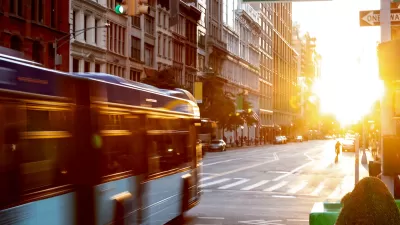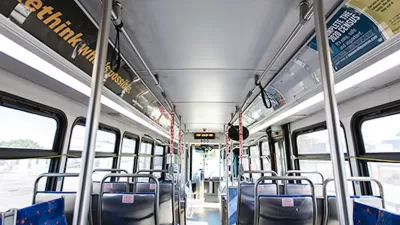Operator shortages are causing transit agencies to cut service unpredictably, leaving riders waiting for ‘ghost buses.’

A blog post from Transit Center explains the phenomenon of “ghost buses,” buses that appear on smartphone apps as minutes away only to never materialize at the station.
“What’s behind this alarming rise in ghost buses? Amid a national shortfall of transit operators, years in the making and worsened by the pandemic, there simply aren’t enough bus operators to run all the trips that transit agencies schedule.” In Los Angeles, the county’s transit agency canceled 1 in 6 trips in January of this year due to a shortage of 600 operators.
There are technical challenges to tracking ghost buses, for riders and agencies alike. Transponders aboard en-route buses share their locations via GPS, feeding real-time arrival boards and trip-planning apps. Canceled trips don’t generate GPS locations, so apps reference and display scheduled arrival data instead. This misleads riders into thinking their bus is running when it’s not.
The blog post recommends that transit agencies begin by tracking and publishing canceled buses to provide more transparency and identify solutions. “Agencies also need to be realistic about the amount of service they can provide with the labor force they have, and adjust schedules accordingly.”
The root of the problem, the blog post cautions, is the structural problems leading to the operator shortage. Transit agencies “must radically improve the job for operators by raising pay and improving working conditions. They must also attract new operators by offering signing bonuses and addressing roadblocks to starting the job, like long waits to receive commercial drivers’ licenses and unnecessarily strict drug testing.”
FULL STORY: Ghost Buses are Haunting Riders Across America

Alabama: Trump Terminates Settlements for Black Communities Harmed By Raw Sewage
Trump deemed the landmark civil rights agreement “illegal DEI and environmental justice policy.”

Planetizen Federal Action Tracker
A weekly monitor of how Trump’s orders and actions are impacting planners and planning in America.

Why Should We Subsidize Public Transportation?
Many public transit agencies face financial stress due to rising costs, declining fare revenue, and declining subsidies. Transit advocates must provide a strong business case for increasing public transit funding.

Understanding Road Diets
An explainer from Momentum highlights the advantages of reducing vehicle lanes in favor of more bike, transit, and pedestrian infrastructure.

New California Law Regulates Warehouse Pollution
A new law tightens building and emissions regulations for large distribution warehouses to mitigate air pollution and traffic in surrounding communities.

Phoenix Announces Opening Date for Light Rail Extension
The South Central extension will connect South Phoenix to downtown and other major hubs starting on June 7.
Urban Design for Planners 1: Software Tools
This six-course series explores essential urban design concepts using open source software and equips planners with the tools they need to participate fully in the urban design process.
Planning for Universal Design
Learn the tools for implementing Universal Design in planning regulations.
Caltrans
Smith Gee Studio
Institute for Housing and Urban Development Studies (IHS)
City of Grandview
Harvard GSD Executive Education
Toledo-Lucas County Plan Commissions
Salt Lake City
NYU Wagner Graduate School of Public Service





























